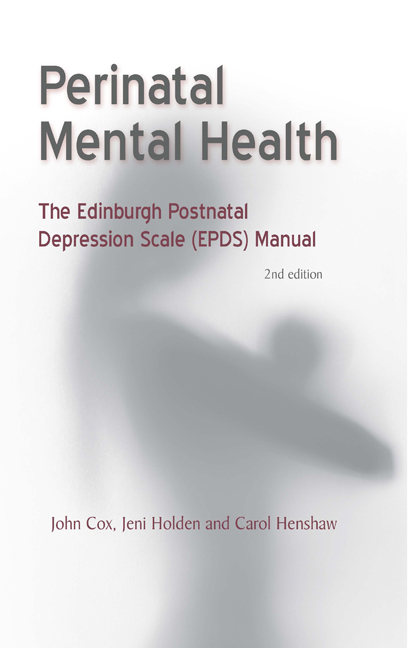Book contents
- Frontmatter
- Contents
- The authors
- Acknowledgments
- Abbreviations
- List of figures
- Foreword
- Preface to the first edition
- Preface to the second edition
- 1 Postnatal depression: an overview
- 2 The origins and development of the Edinburgh Postnatal Depression Scale
- 3 International and cross-cultural issues
- 4 Using the Edinburgh Postnatal Depression Scale in clinical settings: research evidence
- 5 Humanistic and person-centred interventions in perinatal depression
- 6 Screening and intervention services in the community
- 7 Using the Edinburgh Postnatal Depression Scale
- Appendix 1 The Edinburgh Postnatal Depression Scale
- Appendix 2 Translations of the Edinburgh Postnatal Depression Scale
- References
- Index
- Frontmatter
- Contents
- The authors
- Acknowledgments
- Abbreviations
- List of figures
- Foreword
- Preface to the first edition
- Preface to the second edition
- 1 Postnatal depression: an overview
- 2 The origins and development of the Edinburgh Postnatal Depression Scale
- 3 International and cross-cultural issues
- 4 Using the Edinburgh Postnatal Depression Scale in clinical settings: research evidence
- 5 Humanistic and person-centred interventions in perinatal depression
- 6 Screening and intervention services in the community
- 7 Using the Edinburgh Postnatal Depression Scale
- Appendix 1 The Edinburgh Postnatal Depression Scale
- Appendix 2 Translations of the Edinburgh Postnatal Depression Scale
- References
- Index
Summary
‘My husband wants another baby. The idea is quite nice, but it really frightens me to think that after having the baby I would be like this again. I wouldn't mind the morning sickness or the actual birth. It is the postnatal depression that really frightens me. I don't think I could face that again. It was horrific.’
(Holden, 1988)Introduction
Postnatal depression affects not only the quality of a woman's own life and her experience of mothering but also her infant, her other children, her partner and everyone around her, including those involved in her care. On an individual level, the experience can be devastating. Pitt (1968) noted that many of the women in his early study felt quite changed from their normal self, and most ‘had never been depressed like this before’. Without help or treatment, the consequences may be long term and expensive for the women, for their families and in the demands made on healthcare resources. In severe depression, especially with psychotic symptoms, there is a risk of suicide and infanticide. The Confidential Enquiries into Maternal Deaths in the United Kingdom (Oates, 2001), which covered the triennium 1996–1999, first reported psychiatric causes as the leading cause of maternal deaths in the UK and this has remained the case in subsequent reports.
The term ‘postnatal depression’ is commonly used to describe a sustained depressive disorder in women following childbirth, characterised by:
• a low, sad mood
• lack of interest
• anxiety
• sleep difficulties
• reduced self-esteem
• somatic symptoms such as poor appetite and weight loss
• difficulty coping with day-to-day tasks.
The term was used by Vivienne Welburn (1980) as the title of her book and by Ann Oakley (1980) to describe a sustained depressive disorder occurring in women in the first year after childbirth. It was also used in the Edinburgh study (Cox et al, 1982) to describe women experiencing depression within 3 months of childbirth. Cox et al offered the conservative estimate of 13% for the prevalence of depression at that time and report that half of these women were not identified by the local primary care service. In the USA, the term ‘postpartum depression’ is more commonly used to describe mothers with a non-psychotic mood disorder.
- Type
- Chapter
- Information
- Perinatal Mental HealthThe EPDS Manual, pp. 1 - 16Publisher: Royal College of PsychiatristsPrint publication year: 2014



